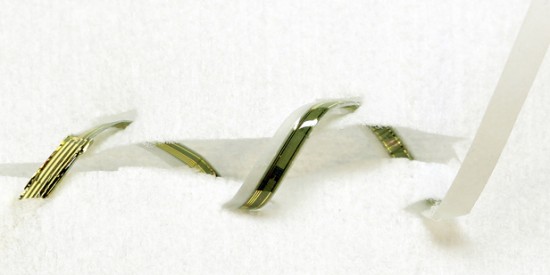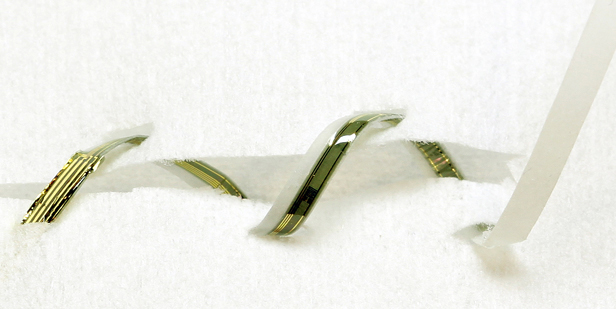Rewriting Life
Smart Sutures That Detect Infections
Plastic or silk threads covered with temperature sensors and micro-heaters could keep tabs on infections and provide therapy.



Surgical sutures are mindless threads no more. Researchers have now coated them with sensors that could monitor wounds and speed up healing.
The electronic sutures, which contain ultrathin silicon sensors integrated on polymer or silk strips, can be threaded through needles, and in animal tests researchers were able to lace them through skin, pull them tight, and knot them without degrading the devices.
The sutures can precisely measure temperature—elevated temperatures indicate infection—and deliver heat to a wound site, which is known to aid healing. And John Rogers, professor of materials science and engineering at the University of Illinois at Urbana-Champaign and inventor of the smart sutures, imagines that they could also be laden with devices that provide electrical stimulation to heal wounds. “Ultimately, the most value would be when you can release drugs from them in a programmed way,” he says. The researchers could do that by coating the electronic threads with drug-infused polymers, which would release the chemicals when triggered by heat or an electrical pulse.
The smart sutures, reported online in the journal Small, rely on silicon-based devices that flex and stretch. Rogers and his colleagues make the devices with silicon membranes and gold electrodes and wires that are just a few hundred nanometers thick and patterned in a serpentine shape. The technology, which they have also used in inflatable catheters and medical tattoos (see “Stick-On Electronic Tattoos”), is being commercialized by MC10, a Cambridge, Massachusetts–based startup Rogers cofounded (see “Making Stretchable Electronics”).
The researchers first use chemicals to slice off an ultrathin film of silicon from a silicon wafer. With a rubber stamp, they lift off and transfer the nanomembranes to polymer or silk strips. Then they deposit metal electrodes and wires on top and encapsulate the entire device in an epoxy coating.
They have built two types of temperature sensors on the sutures. One is a silicon diode that shifts its current output with temperature; the other, a platinum nanomembrane resistor, changes its resistance with temperature. The micro-heaters, meanwhile, are simply gold filaments that heat up when current passes through them.
All the materials used in the devices are safe for use in the body, and the biggest challenge was to make the sutures flexible, Rogers says. Silicon is brittle, so making the nanomembranes as thin as possible and laying them out in a winding pattern was key for elasticity. Placing the silicon halfway between the top epoxy and bottom polymer surfaces of the suture is also crucial. “When you bend the entire construct, the top surface is in tension and the bottom is in compression, but at midpoint the strains are very small,” he says.
The researchers have tested the sutures’ mechanical flexibility and toughness on incisions in rat skin, but they haven’t tested the temperature sensing and heating capabilities in animals yet. They are also working on making the devices wireless.